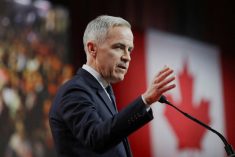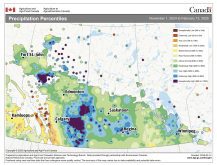After a year at elevated levels, oil prices are back near where they were before Russia invaded Ukraine but diesel, while moderated, is still above pre-invasion prices .
With the seeding season only a few weeks away, Canadian farmers hope their diesel costs don’t see a repeat of last year when prices soared in response to the global energy market disruption that accompanied Russia’s aggression.
It is good to note that crude oil prices have settled into a steady trading range of about US$72 to $82 per barrel for West Texas Intermediate. Brent crude has been in a range of about US$80-$88 this year.
Read Also

Chinese offer complicates canola marketing
Recently the Chinese ambassador indicated that there would be a potential deal between Canada and China regarding the current tariff war.
GasBuddy tracks diesel and gasoline prices. It shows that diesel at the pump in Calgary has dropped to C$1.48 per litre from $1.77 at the start of the year. Alberta has suspended its provincial fuel tax. In Regina and Winnipeg, diesel pump prices at the start of March had dropped to about $1.64.
In mid-January last year, diesel in all three jurisdictions was around $1.40. After the invasion, prices spiked and for several periods topped $2 per litre before beginning to fall in December.
Taxes and refinery capacity have a bearing on diesel prices and the newly expanded Exxon Mobile refinery at Beaumont, Texas, as well as new refinery capacity elsewhere in the world might provide modest downward pressure on diesel.
But the biggest driver of diesel and gasoline is crude oil.
In this column, I’ll look at the factors that have the potential to alter the crude oil range, higher or lower.
On the demand side, the main factors are China’s economic recovery from its draconian zero-COVID policies, and in the rest of the world, the impact of inflation and the interest rate increases on economic activity.
On the supply side, analysts are watching production quotas set by the Organization of Petroleum Exporting Countries and whether capital expenditures in oil production are enough to meet expected demand.
Russia’s war with Ukraine is a wildcard. Increasing hostilities have the potential to generate more sanctions against Russian oil, but a turn toward peace negotiations might remove sanctions.
China’s economy and oil demand faltered last year as COVID outbreaks brought repeated lockdowns to major industrial areas. The lockdown policies ended in December.
Economic data for February showed a rebound was underway.
With economies still rebounding from COVID last year and a mild winter in many parts of the world, global oil production actually outstripped demand in the fourth quarter, allowing a slight rise in global stocks, but that might change in the coming months.
The International Energy Agency, the Paris-based international body providing energy analysis to 31 member countries and 11 associated countries, said last month it expects global oil demand to rise to 101.9 million barrels a day, up two million compared to 2022.
It expects China’s growth to make up 900,000 barrels of that. Other Asia-Pacific countries are also expected to see robust growth.
Demand growth from North America and Europe is expected to be modest as interest rate increases slow economic activity but do not push countries into recession.
The IEA sees oil production rising this year by 1.2 million barrels a day, lifting the total to 102 million, leaving a razor thin spare capacity.
OPEC wants to leave the bloc’s production steady so growth will come from the United States, Canada, Brazil, Norway and Guyana, IEA said.
The economic sanctions on Russia are making it hard to sell all its production and it announced a 500,000 barrel per day production cut recently.
Investment bank Morgan Stanley’s recent oil outlook said it expects the supply-demand relationship to tighten in the second half of the year, leading to Brent crude rising to US$90-$100 per barrel, but that was down from an earlier forecast of $100-$110 in the second half.
That would imply Brent would rise by $10-$20 from current levels.
Another bank, Goldman Sachs, also expects a gradual rise, but has pushed back its $100 target to December from an earlier forecast of $100 at mid-year.
A more cautious bank outlook comes from J.P. Morgan. It also sees tighter supply-demand balance in the second half of the year but doubts that $100 will be reached.
Looking to 2024, several analysts think demand will continue to rise but global investment in new oil production is failing to keep up.
Big oil companies are mindful of investors’ demands for improved dividends after a decade of poor performance, rather than investments in new production.
Also, the push toward greener transportation makes long-term investment in petroleum risky.
However, oil demand could continue to grow for another 10 years before the transition to electric and alternative fuel transportation finally strangles oil demand.















